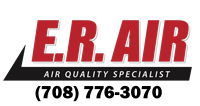How Does Mold End Up In My Ductwork?
You may have heard that one of the things we air duct cleaners are likely to find in ductwork is mold. But what set of conditions actually cause mold to develop in the ductwork of the average home? Here’s a quick explanation:
By definition, the air your HVAC is pushing out is a different temperature from the ambient air around your home. During the summer, cool air flows through your vents, but the warmer ambient air around the ducts causes condensation to form on the duct walls. It’s the same principle that causes the outside of a cold glass of water to condense on a hot day.
The presence of this moisture, if it occurs often enough, can create a perfect environment for mold. But mold doesn’t come from nowhere: mold spores are carried through the air and are ever-present in our environment. They settle in the most environment of your vents and can then proliferate.

What To Look For
Does your home get a musty smell when you turn the air on? If so, you might be dealing with mold issues. Likewise, if you have irritation of the eyes, nose, or throat, whenever your furnace is running, that might be a sign of a mold issue. Finally, you may be able to see the mold in your vents. If you suspect you might have a mold issue, simply remove one or more of the covers and check the inside of the vent surface for conspicuous dark spots.
The only way to get rid of the mold in your vents is a thorough cleaning. At ER Air, we not only clean your vents, but use cleaning chemicals that can put a stop to your mold issues and drastically improve the air quality in your home. Contact us to schedule your appointment!
